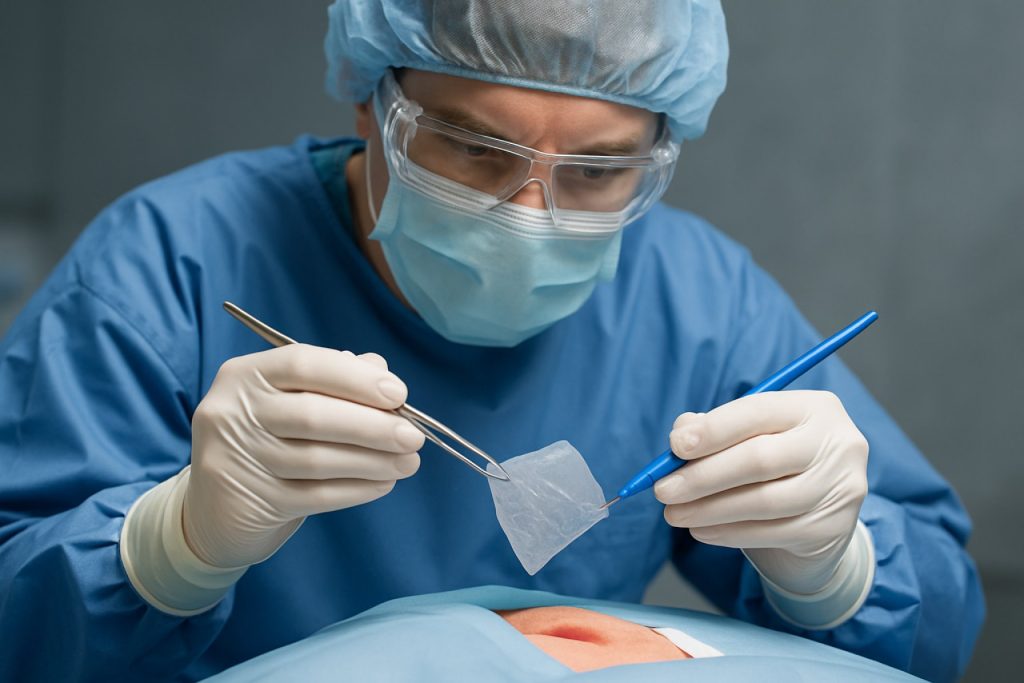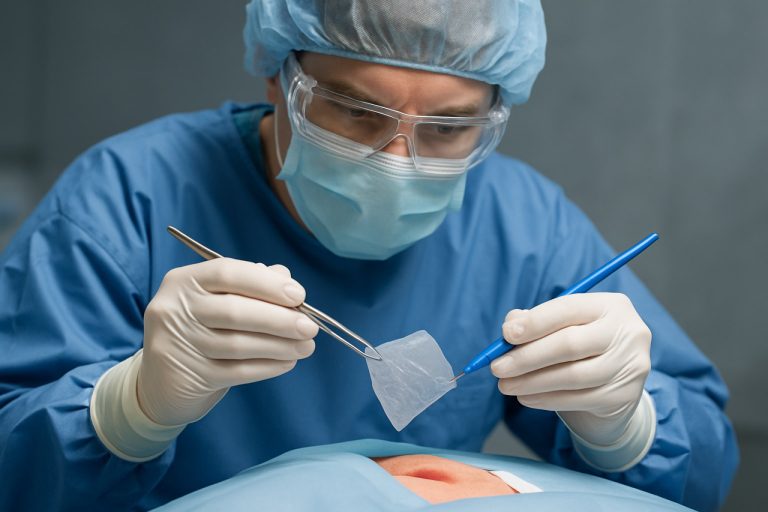
Unlocking the Healing Power of Human Amnion Membrane Transplantation: How This Advanced Therapy Is Transforming Wound Care and Beyond. Discover the Science, Applications, and Future Potential. (2025)
- Introduction to Human Amnion Membrane Transplantation
- Biological Properties and Mechanisms of Action
- Clinical Applications: Wound Healing, Ophthalmology, and More
- Processing, Preservation, and Quality Standards
- Regulatory Landscape and Ethical Considerations
- Key Manufacturers and Official Guidelines
- Comparative Effectiveness: Amnion vs. Alternative Grafts
- Market Growth and Public Interest: 2024–2030 Forecast
- Emerging Technologies and Research Frontiers
- Future Outlook: Expanding Indications and Global Impact
- Sources & References
Introduction to Human Amnion Membrane Transplantation
Human amnion membrane transplantation (HAMT) has emerged as a significant advancement in regenerative medicine, leveraging the unique biological properties of the amniotic membrane derived from the innermost layer of the placenta. The amniotic membrane is rich in growth factors, anti-inflammatory proteins, and extracellular matrix components, making it an attractive option for promoting tissue repair and modulating immune responses. In 2025, HAMT is increasingly utilized in ophthalmology, wound care, and reconstructive surgery, reflecting a growing body of clinical evidence supporting its efficacy and safety.
The clinical use of human amnion membrane dates back to the early 20th century, but recent years have seen a surge in its application due to improved processing techniques and stricter donor screening protocols. The membrane is typically processed as a cryopreserved, dehydrated, or lyophilized graft, ensuring sterility and preservation of bioactive molecules. Regulatory oversight by agencies such as the U.S. Food and Drug Administration and the European Medicines Agency has contributed to standardized manufacturing and quality assurance, facilitating broader clinical adoption.
In ophthalmology, HAMT is widely used for ocular surface reconstruction, particularly in the management of persistent epithelial defects, chemical burns, and pterygium surgery. Recent multicenter studies have demonstrated improved healing rates and reduced inflammation in patients treated with amniotic membrane grafts compared to conventional therapies. In wound care, especially for chronic diabetic foot ulcers and burns, HAMT has shown promise in accelerating re-epithelialization and reducing infection rates, as highlighted in ongoing clinical trials registered with the U.S. National Institutes of Health.
The outlook for HAMT in 2025 and the coming years is optimistic, with ongoing research focused on optimizing membrane processing, expanding indications, and developing combination therapies with stem cells or bioengineered scaffolds. Leading organizations such as the International Society for Cell & Gene Therapy and the American Association of Tissue Banks are actively involved in setting guidelines and promoting best practices for tissue procurement and transplantation. As the global demand for regenerative therapies grows, HAMT is poised to play an increasingly central role in multidisciplinary clinical care, supported by robust regulatory frameworks and a strong foundation of translational research.
Biological Properties and Mechanisms of Action
Human amnion membrane transplantation (HAMT) leverages the unique biological properties of the amniotic membrane, a tissue derived from the innermost layer of the placenta. In 2025, research and clinical practice continue to elucidate the mechanisms by which HAMT exerts its therapeutic effects, particularly in ophthalmology, wound healing, and regenerative medicine. The amniotic membrane is characterized by its anti-inflammatory, anti-fibrotic, anti-microbial, and low immunogenicity properties, making it an attractive biological scaffold for tissue repair.
The amniotic membrane contains a rich extracellular matrix composed of collagen types I, III, IV, V, and VII, fibronectin, and laminin, which provide structural support and promote cellular adhesion and migration. It also harbors a variety of growth factors, such as epidermal growth factor (EGF), transforming growth factor-beta (TGF-β), and basic fibroblast growth factor (bFGF), which are critical for modulating inflammation, stimulating epithelialization, and enhancing angiogenesis. These factors collectively contribute to accelerated wound healing and reduced scar formation, as demonstrated in ongoing clinical trials and translational studies.
A key mechanism of HAMT is its ability to modulate the local immune response. The membrane expresses anti-inflammatory cytokines and suppresses pro-inflammatory mediators, thereby reducing infiltration of neutrophils and macrophages at the site of injury. This immunomodulatory effect is further supported by the presence of mesenchymal stem cells within the amniotic membrane, which have been shown to secrete paracrine factors that promote tissue regeneration and inhibit fibrosis. Recent studies in 2024 and 2025 have focused on optimizing the preservation and processing of amniotic tissue to retain these bioactive components, with organizations such as the U.S. Food and Drug Administration and the American Association of Tissue Banks providing updated guidelines for safety and efficacy.
Another important property is the membrane’s anti-microbial activity, attributed to the presence of natural antimicrobial peptides and proteins. This reduces the risk of infection in transplanted sites, a feature particularly valuable in chronic wound management and ocular surface reconstruction. The low immunogenicity of the amniotic membrane, due to the absence of major histocompatibility complex (MHC) antigens, allows for allogeneic transplantation with minimal risk of rejection, a fact increasingly recognized in regulatory frameworks and clinical protocols.
Looking ahead, ongoing research is expected to further clarify the molecular pathways involved in HAMT and to develop advanced processing techniques that maximize the retention of its biological properties. The integration of HAMT with emerging cell-based therapies and bioengineered scaffolds is anticipated to expand its clinical applications, with oversight and guidance from regulatory and scientific bodies such as the European Medicines Agency and the World Health Organization.
Clinical Applications: Wound Healing, Ophthalmology, and More
Human amnion membrane transplantation (HAMT) has rapidly advanced as a versatile therapeutic approach in several clinical domains, with significant developments expected in 2025 and the near future. The amniotic membrane, derived from the innermost layer of the placenta, possesses unique anti-inflammatory, anti-fibrotic, and pro-regenerative properties, making it highly valuable for tissue repair and regeneration.
In wound healing, HAMT is increasingly utilized for chronic and complex wounds, including diabetic foot ulcers, venous leg ulcers, and burns. Recent clinical trials and real-world studies have demonstrated that amniotic membrane allografts can accelerate re-epithelialization, reduce pain, and lower infection rates compared to conventional dressings. In 2025, ongoing multicenter studies are expected to further validate these benefits, with a focus on standardized protocols and long-term outcomes. The U.S. Food and Drug Administration continues to regulate and monitor the safety and efficacy of amniotic-derived products, with several products already cleared for wound management under the Human Cells, Tissues, and Cellular and Tissue-Based Products (HCT/Ps) framework.
Ophthalmology remains a leading field for HAMT, particularly in the management of ocular surface disorders such as persistent epithelial defects, chemical burns, and pterygium surgery. The amniotic membrane serves as a biological bandage, promoting healing while minimizing scarring and inflammation. In 2025, the adoption of sutureless and cryopreserved amniotic membrane technologies is expected to increase, offering improved patient comfort and surgical efficiency. Organizations such as the American Academy of Ophthalmology provide clinical guidelines and educational resources to support the integration of HAMT into ophthalmic practice.
Beyond wound care and ophthalmology, HAMT is being explored in other specialties, including oral and maxillofacial surgery, gynecology, and orthopedics. Early-phase studies suggest potential benefits in reducing adhesions, enhancing graft integration, and supporting soft tissue regeneration. In the coming years, collaborative research efforts and registries are anticipated to generate robust data on these emerging indications.
Looking ahead, the clinical outlook for HAMT is promising, driven by ongoing innovation in membrane processing, preservation, and delivery methods. Regulatory agencies such as the European Medicines Agency and the U.S. Food and Drug Administration are expected to play pivotal roles in shaping standards and ensuring patient safety as new products and applications reach the market. As evidence accumulates, HAMT is poised to become an integral component of regenerative medicine strategies across multiple disciplines.
Processing, Preservation, and Quality Standards
In 2025, the processing, preservation, and quality standards for human amnion membrane transplantation are experiencing significant refinement, driven by advances in tissue engineering, regulatory oversight, and clinical demand. The human amniotic membrane, derived from the innermost layer of the placenta, is valued for its anti-inflammatory, anti-fibrotic, and pro-regenerative properties, making it a critical allograft in ophthalmology, wound care, and reconstructive surgery.
Current processing protocols emphasize aseptic recovery, decontamination, and decellularization to minimize immunogenicity and pathogen transmission. Leading tissue banks and organizations, such as the American Association of Tissue Banks (AATB), have updated their guidelines to reflect best practices in donor screening, serological testing, and traceability. In 2025, the AATB’s standards are widely adopted in North America, ensuring that amnion grafts meet rigorous safety and efficacy benchmarks.
Preservation techniques have also evolved. While cryopreservation remains the gold standard for maintaining the structural and biological integrity of amnion tissue, recent years have seen increased adoption of lyophilization (freeze-drying) and dehydration methods. These approaches facilitate room-temperature storage and simplify logistics, particularly for remote or resource-limited settings. The U.S. Food and Drug Administration (FDA) continues to regulate amnion-based products as human cells, tissues, and cellular and tissue-based products (HCT/Ps) under 21 CFR Part 1271, mandating stringent controls on processing environments, labeling, and post-market surveillance.
Globally, harmonization of quality standards is a priority. The World Health Organization (WHO) and regional authorities are collaborating to establish minimum requirements for donor eligibility, microbial testing, and documentation, aiming to reduce variability in product quality and patient outcomes. In the European Union, the European Directorate for the Quality of Medicines & HealthCare (EDQM) is actively updating its monographs and technical guidelines for human tissue allografts, including amnion, to reflect the latest scientific evidence and clinical experience.
Looking ahead, the next few years are expected to bring further integration of advanced sterilization technologies, such as supercritical CO2 and gamma irradiation, to enhance safety without compromising bioactivity. Digital traceability systems and blockchain-based documentation are also being piloted to improve transparency and compliance across the supply chain. As regulatory frameworks mature and international cooperation intensifies, the outlook for standardized, high-quality human amnion membrane transplantation is increasingly robust, promising safer and more effective therapies for patients worldwide.
Regulatory Landscape and Ethical Considerations
The regulatory landscape for human amnion membrane transplantation is evolving rapidly as clinical applications expand and new products enter the market. In 2025, regulatory agencies such as the U.S. Food and Drug Administration (FDA) and the European Medicines Agency (EMA) continue to play pivotal roles in shaping standards for the procurement, processing, and clinical use of amniotic tissues. In the United States, amnion-derived products are generally regulated under the framework for Human Cells, Tissues, and Cellular and Tissue-Based Products (HCT/Ps), specifically under 21 CFR Part 1271. Products that meet the criteria for minimal manipulation and homologous use may be marketed without premarket approval, but those intended for non-homologous uses or that are more than minimally manipulated require premarket review as biologics or medical devices. The FDA has increased enforcement actions in recent years, emphasizing compliance with good tissue practices and accurate product labeling.
In Europe, the EMA and national competent authorities oversee the regulation of human tissue-based products, including amnion membrane transplants, under the European Union Tissues and Cells Directive (EUTCD). This directive sets stringent requirements for donor screening, traceability, and quality assurance. The EMA also evaluates advanced therapy medicinal products (ATMPs), which may include certain processed amnion-derived products, through a centralized procedure. Recent updates to the EUTCD and ongoing harmonization efforts are expected to further standardize practices across member states in the coming years.
Ethical considerations remain central to the field. The voluntary and informed consent of donors is a foundational requirement, with organizations such as the World Health Organization (WHO) and the International Committee of Medical Journal Editors (ICMJE) providing guidance on ethical procurement and transparency. The non-embryonic origin of amnion tissue generally reduces ethical controversy compared to other sources, but issues such as equitable access, commercialization, and long-term safety monitoring persist. In 2025, there is growing emphasis on international collaboration to ensure ethical sourcing and to prevent exploitation, particularly in low- and middle-income countries where regulatory oversight may be less robust.
Looking ahead, regulatory agencies are expected to refine guidelines to address emerging technologies, such as decellularized and bioengineered amnion membranes, and to clarify the distinction between tissue transplants and advanced therapy products. Stakeholders anticipate increased harmonization of standards globally, with a focus on patient safety, product efficacy, and ethical stewardship. Ongoing dialogue among regulators, clinicians, and bioethicists will be crucial as the field continues to advance.
Key Manufacturers and Official Guidelines
Human amnion membrane transplantation (HAMT) has seen significant advancements in both clinical adoption and manufacturing standards as of 2025. The field is shaped by a combination of established tissue banks, biotechnology companies, and evolving regulatory frameworks that ensure safety, efficacy, and ethical sourcing.
Key manufacturers of human amnion membrane products include both non-profit tissue banks and commercial entities. In the United States, American Association of Tissue Banks (AATB) sets accreditation standards for tissue procurement and processing, and many leading tissue banks operate under its guidelines. Notable AATB-accredited organizations include Musculoskeletal Transplant Foundation (MTF), which supplies amniotic tissue for a range of surgical and wound care applications, and LifeNet Health, a major non-profit provider of allograft tissues, including amnion-based products.
On the commercial side, companies such as MiMedx Group and Organogenesis are prominent in the development and distribution of amniotic membrane allografts. These companies have invested in proprietary processing technologies to preserve the biological properties of the amnion while ensuring sterility and regulatory compliance. Their products are widely used in ophthalmology, wound healing, and surgical reconstruction.
Internationally, organizations like the Eurotransplant International Foundation and the International Council for Commonality in Blood Banking Automation (ICCBBA) contribute to harmonizing tissue banking standards and traceability, which is increasingly important as cross-border transplantation grows.
Official guidelines for HAMT are primarily issued by regulatory agencies and professional societies. In the U.S., the U.S. Food and Drug Administration (FDA) regulates human tissue products under the Human Cells, Tissues, and Cellular and Tissue-Based Products (HCT/Ps) framework, requiring donor screening, tissue processing controls, and post-market surveillance. The American Academy of Ophthalmology (AAO) and the Wound Healing Society provide clinical practice guidelines for the use of amniotic membranes in ocular surface reconstruction and chronic wound management, respectively.
Looking ahead, the next few years are expected to bring further harmonization of international standards, increased adoption of digital traceability systems, and ongoing innovation in processing methods. Regulatory agencies are anticipated to refine guidance on minimally manipulated versus more extensively processed amnion products, impacting both market access and clinical practice. As clinical evidence accumulates, official guidelines will likely expand to cover new indications and best practices for HAMT.
Comparative Effectiveness: Amnion vs. Alternative Grafts
In 2025, the comparative effectiveness of human amnion membrane transplantation (HAMT) versus alternative graft materials remains a central focus in regenerative medicine and surgical practice. Human amnion membrane, derived from the innermost layer of the placenta, is increasingly utilized due to its unique biological properties, including anti-inflammatory, anti-fibrotic, and antimicrobial effects, as well as its ability to promote epithelialization and reduce scarring. These attributes have positioned HAMT as a promising option for a range of clinical applications, from ophthalmology and wound care to reconstructive surgery.
Recent clinical studies and meta-analyses have continued to compare HAMT with other graft materials such as autografts, allografts, xenografts, and synthetic matrices. In ophthalmology, for example, HAMT has demonstrated superior outcomes in the management of persistent epithelial defects and corneal ulcers compared to conventional therapies, with faster healing times and reduced risk of infection. In chronic wound management, particularly for diabetic foot ulcers, randomized controlled trials have shown that amnion-based grafts can achieve higher rates of complete wound closure and lower recurrence rates than standard care or synthetic dressings. These findings are supported by ongoing research and clinical guidelines from organizations such as the American Academy of Ophthalmology and the Wound Healing Society.
Alternative grafts, including autologous skin grafts and bioengineered tissue substitutes, remain widely used, especially in large or complex wounds. However, these options often involve donor site morbidity, increased risk of immune rejection, or higher costs. In contrast, HAMT offers an off-the-shelf, immunologically privileged solution with minimal risk of disease transmission when properly processed. Regulatory bodies such as the U.S. Food and Drug Administration have approved several amnion-derived products for clinical use, reflecting their safety and efficacy profiles.
Looking ahead, the next few years are expected to bring further head-to-head trials and real-world evidence comparing HAMT with emerging alternatives, including next-generation bioengineered matrices and stem cell-based therapies. The integration of HAMT into standardized treatment protocols is likely to expand, particularly as cost-effectiveness analyses and long-term outcome data become available. Collaborative efforts between clinical researchers, tissue banks, and regulatory agencies will be crucial in refining indications and optimizing patient outcomes. As of 2025, HAMT stands as a leading biologic graft material, with ongoing innovation and comparative research poised to further define its role relative to alternative grafting strategies.
Market Growth and Public Interest: 2024–2030 Forecast
The market for Human Amnion Membrane Transplantation (HAMT) is poised for significant growth between 2024 and 2030, driven by expanding clinical applications, increasing public awareness, and ongoing regulatory support. HAMT, which utilizes the innermost layer of the placenta for its anti-inflammatory, anti-scarring, and regenerative properties, has seen rising adoption in ophthalmology, wound care, and surgical reconstruction. In 2025, the global demand is expected to accelerate, with North America and Europe leading due to robust healthcare infrastructure and active research environments.
Key drivers include the growing prevalence of chronic wounds, diabetic ulcers, and ocular surface disorders, all of which benefit from HAMT’s unique healing properties. The U.S. Food and Drug Administration continues to play a pivotal role by providing regulatory pathways for amniotic membrane products, ensuring safety and efficacy while encouraging innovation. In Europe, the European Medicines Agency supports the development and approval of advanced therapy medicinal products, including those derived from human tissues, further facilitating market entry.
Public interest in regenerative medicine and biologically derived therapies is also on the rise, fueled by increased patient advocacy and educational initiatives from organizations such as the American Academy of Ophthalmology and the European Wound Management Association. These bodies actively disseminate clinical guidelines and research findings, helping to build trust and awareness among both clinicians and patients.
From a commercial perspective, several leading tissue banks and biotherapeutics companies are scaling up production and distribution of amnion-based products. Entities like the American Association of Tissue Banks set standards for tissue procurement and processing, ensuring product quality and traceability. The entry of new players and the expansion of existing portfolios are expected to intensify competition and drive innovation, particularly in the development of next-generation, processed amnion grafts with enhanced shelf life and handling characteristics.
Looking ahead to 2030, the HAMT market is projected to benefit from ongoing clinical trials, broader insurance coverage, and the integration of digital health tools for patient monitoring and outcome tracking. As regulatory frameworks mature and public confidence grows, HAMT is likely to become a mainstay in regenerative medicine, with applications expanding beyond current indications to include novel uses in orthopedics, dentistry, and even neurology.
Emerging Technologies and Research Frontiers
Human amnion membrane transplantation (HAMT) is experiencing a surge of innovation and research momentum as of 2025, driven by advances in tissue engineering, preservation techniques, and clinical applications. The amniotic membrane, derived from the innermost layer of the placenta, is prized for its anti-inflammatory, anti-fibrotic, and pro-regenerative properties, making it a versatile biological scaffold in regenerative medicine.
Recent years have seen the refinement of decellularization and sterilization protocols, which are critical for ensuring the safety and efficacy of HAMT products. Researchers are increasingly employing advanced cryopreservation and lyophilization methods to extend shelf life and maintain the bioactivity of amnion-derived grafts. These improvements are enabling broader distribution and on-demand clinical use, particularly in ophthalmology, wound healing, and reconstructive surgery.
In 2025, several clinical trials are underway to evaluate next-generation amnion-based products. Notably, there is growing interest in combining amnion membranes with stem cells or bioactive molecules to enhance therapeutic outcomes. Early-phase studies suggest that such composite grafts may accelerate epithelialization and reduce scarring in chronic wounds and burns. Furthermore, the integration of amnion membranes with 3D bioprinting technologies is being explored to create patient-specific grafts for complex tissue defects.
Regulatory agencies, including the U.S. Food and Drug Administration and the European Medicines Agency, are actively updating guidelines to address the unique challenges posed by human tissue-derived products. This regulatory evolution is expected to streamline the approval process for innovative HAMT therapies while ensuring patient safety.
Key organizations such as the American Association of Tissue Banks are setting standards for donor screening, processing, and quality assurance, which are crucial for maintaining public trust and clinical outcomes. Meanwhile, academic consortia and hospital-based biobanks are collaborating to establish large-scale repositories of amnion tissue, facilitating multicenter studies and accelerating translational research.
Looking ahead, the next few years are likely to witness the expansion of HAMT into new therapeutic areas, including neurology and orthopedics, as preclinical data accumulates. The convergence of biomaterials science, cell therapy, and digital health is poised to unlock further potential, positioning human amnion membrane transplantation as a cornerstone of regenerative medicine in the near future.
Future Outlook: Expanding Indications and Global Impact
Human amnion membrane transplantation (HAMT) is poised for significant expansion in both clinical indications and global reach in 2025 and the coming years. Traditionally utilized in ophthalmology—particularly for ocular surface reconstruction and treatment of persistent epithelial defects—HAMT is now being investigated and adopted for a broader range of medical applications. This trend is driven by the membrane’s unique biological properties, including anti-inflammatory, anti-fibrotic, and pro-regenerative effects, as well as its low immunogenicity.
In 2025, ongoing and recently completed clinical trials are evaluating HAMT in diverse fields such as dermatology (for chronic wounds and burns), orthopedics (for tendon and cartilage repair), and even in surgical applications for reducing postoperative adhesions. The expansion is supported by a growing body of evidence demonstrating improved healing rates, reduced scarring, and enhanced patient outcomes compared to conventional therapies. Regulatory agencies in several regions, including the United States and the European Union, have granted or are reviewing designations for amniotic membrane products as advanced therapy medicinal products or human tissue-based products, facilitating broader clinical adoption.
Key organizations such as the U.S. Food and Drug Administration and the European Medicines Agency are actively shaping the regulatory landscape, with updated guidance on the classification, processing, and clinical use of human tissue-derived products. These regulatory developments are expected to streamline approval pathways and encourage innovation in HAMT-based therapies.
On the manufacturing and distribution front, several tissue banks and biotechnology companies are scaling up production capacities and investing in advanced preservation and sterilization technologies to ensure consistent quality and safety of amnion-derived grafts. Organizations such as the American Association of Tissue Banks are instrumental in setting standards for tissue procurement, processing, and transplantation, which is critical for global harmonization and patient safety.
Looking ahead, the global impact of HAMT is likely to be most pronounced in regions with high burdens of chronic wounds, burns, and ocular diseases, particularly in low- and middle-income countries where access to advanced wound care remains limited. International collaborations and technology transfer initiatives are expected to play a pivotal role in expanding access to HAMT, with support from entities like the World Health Organization in promoting safe and ethical use of human tissues.
In summary, 2025 marks a pivotal year for HAMT, with expanding clinical indications, evolving regulatory frameworks, and increasing global accessibility setting the stage for broader adoption and improved patient outcomes worldwide.
Sources & References
- European Medicines Agency
- U.S. National Institutes of Health
- International Society for Cell & Gene Therapy
- American Association of Tissue Banks
- World Health Organization
- American Association of Tissue Banks
- European Directorate for the Quality of Medicines & HealthCare
- International Committee of Medical Journal Editors
- LifeNet Health
- Organogenesis
- International Council for Commonality in Blood Banking Automation
- Wound Healing Society
- Wound Healing Society
- American Academy of Ophthalmology



